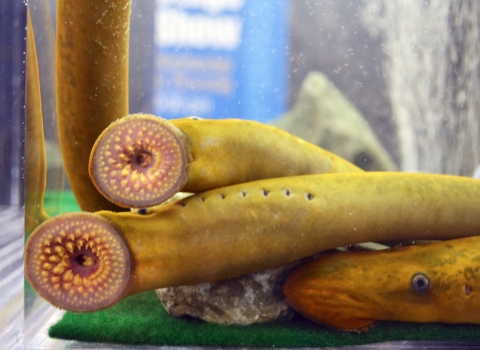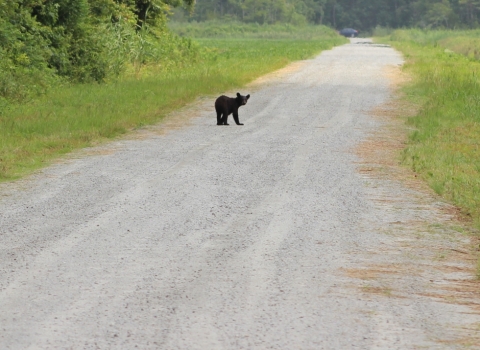Spring is here. Birds are chirping, plants are waking up and animals are coming out of hibernation - a few of them are even hoping to use their vocalization skills to attract a mate! Throughout the next few months, the wetlands will begin to liven up and frogs and toads will fill the air with their mating calls.
Too many croaks in the wetland!
In Minnesota, there are 14 different species of toads and frogs. These amphibians are grouped into subsets: Family Ranidae (true frogs), Family Hylidae (treefrogs) and Family Bufonidae (toads). There are a few methods of differentiating these families. True frogs, such as bullfrogs and pickerel frogs, are the largest in size; however, unlike treefrogs, their front toes are not as webbed. Treefrogs, including spring peepers and Cope’s gray tree frogs, are the smallest in size, roughly the size of a USB stick or smaller, and have toe pads that allow them to climb high into trees. Lastly, toads, including the American toad and great plains toad, have dry and warty skin with glands that produce a bitter liquid that causes their head and back to be unappetizing to predators. Additionally, their short, stout bodies enable them to hop but make it hard to leap like treefrogs and true frogs.
Having similar characteristics and being grouped into families does not guarantee each species in that family will live in the same habitat. There are three main habitats that toads and frogs call their home in Minnesota: forest and woodlands, grasslands, and lakes and streams. In each habitat, these species have to adapt to cold winter temperatures, finding food and more importantly, finding a mate.
Vocalization is important for most frogs and toads during mating season. Male frogs and toads will call by breathing in air with their lungs and then bouncing the air between their single or paired vocal sacs and lungs. This causes their vocal cords to vibrate, creating their amplified signature croak! Although people tend to notice them in the evening, some toads and frogs croak during the day or after rain. So, as spring is approaching, who is croaking?
Different croaks for different folks.
Some species of toads and frogs start appearing for the first time as the snow starts to melt. The northern leopard frog is one of the first few species to perform their mating call. Standing near a shallow wetland in the prairie, they breathe in and force air to their paired vocal sacs for a big, deep snore followed by a chuckling, “chuck-chuck-chuck.” An American toad is another early breeder to sing along in the spring. Laying in a temporary wetland, or vernal pool, in the marsh, they puff out their vocal sac for a long trill –rrrrrr-. When calling for a mate, both the northern leopard frogs and American toads are a few of the species known for being explosive breeders. Explosive breeders gather in large numbers and call for mates for only a few days, using temporary wetlands to breed as there would be no fish to eat their eggs. They will often stop calling for short periods of times to pick off a receptive female hopping towards a call.
Other species of toads and frogs start calling later in the summer, such as the gray treefrog. These frogs perch on plants near temporary wetlands in the forests, force air to their vocal sacs and let out a slow musical trill. This occurs from late May to late June. At the same time, green frogs, known for their blue or brown coloring, start calling. Floating in streams or waterways, they let out a big deep, “boink.” Gray treefrogs and green frogs are known to be prolonged breeders in which they call for mates for several weeks, develop territories and defend them from other calling males.
During the mating periods, female frogs and toads will listen carefully and hop closer to the males that have a deeper or more powerful call, indicating their larger size which suggests a greater ability to survive and reproduce. Additionally, frogs and toads that are larger and more aggressive are ideal when defending territories when eggs are present. After mates are selected, females will lay eggs. Frog eggs are generally laid in a cluster formation while toad eggs are in a long, single lined formation.
Ready to hear some croaks? Hop on over to the refuge!
With warm weather upon us and even warmer days to come, what better opportunity to spot and hear these croaking creatures than at the refuge? In April, there are five different species of frogs and toads in the area calling for a mate: American toad, boreal chorus frog, northern leopard frog, spring peeper and wood frog. The American toad is one of the first toad species to call for a mate. As mentioned above, they lay in a temporary wetland in the forest, they puff out their vocal sac for a long trill –rrrrrr-. After American toads mate, they found in areas nearby forest, grasslands, or even residential yards. The boreal chorus frog, known for being the most commonly heard, are also the hardest to see as they are the smallest frog in Minnesota, averaging about the size of a quarter. Their bodies are colored a tannish gray, and they have three dark lines running down their back. Boreal chorus frogs call throughout the day and night across Minnesota’s wetlands and fields, their call sounding like a high “creek.” The spring peeper, known for the dark ‘X’ on their tannish body, have high-pitched frog sounds, very similar to a baby bird’s “peep.” You may find them on plants near the temporary wetlands in the northern and eastern Minnesota woodlands. The northern leopard frog, as mentioned above, are known for their rows of leopard spots. You may find them in temporary wetlands of prairies as they let out a big, deep snore followed by a “chuck-chuck-chuck.” Lastly, the wood frog, known for the dark mask around their eyes with dark stripes down their back. Based on their name, they look for temporary wetlands in the forests where they let out a harsh ducklike call of “racket, racket, racket.” If you want to hear toad and frog calls to compare to the written description, the Amphibian and Reptile Survey of Minnesota provides calls to listen as well as information to report what you have spotted or heard!
Whether it be early in the morning or late evening after dark, many of the 50 miles of refuge trails are maintained during the spring season and are open from 5 am to 10 pm daily. Put on your muddiest shoes and go look for these unfrogettable creatures!









